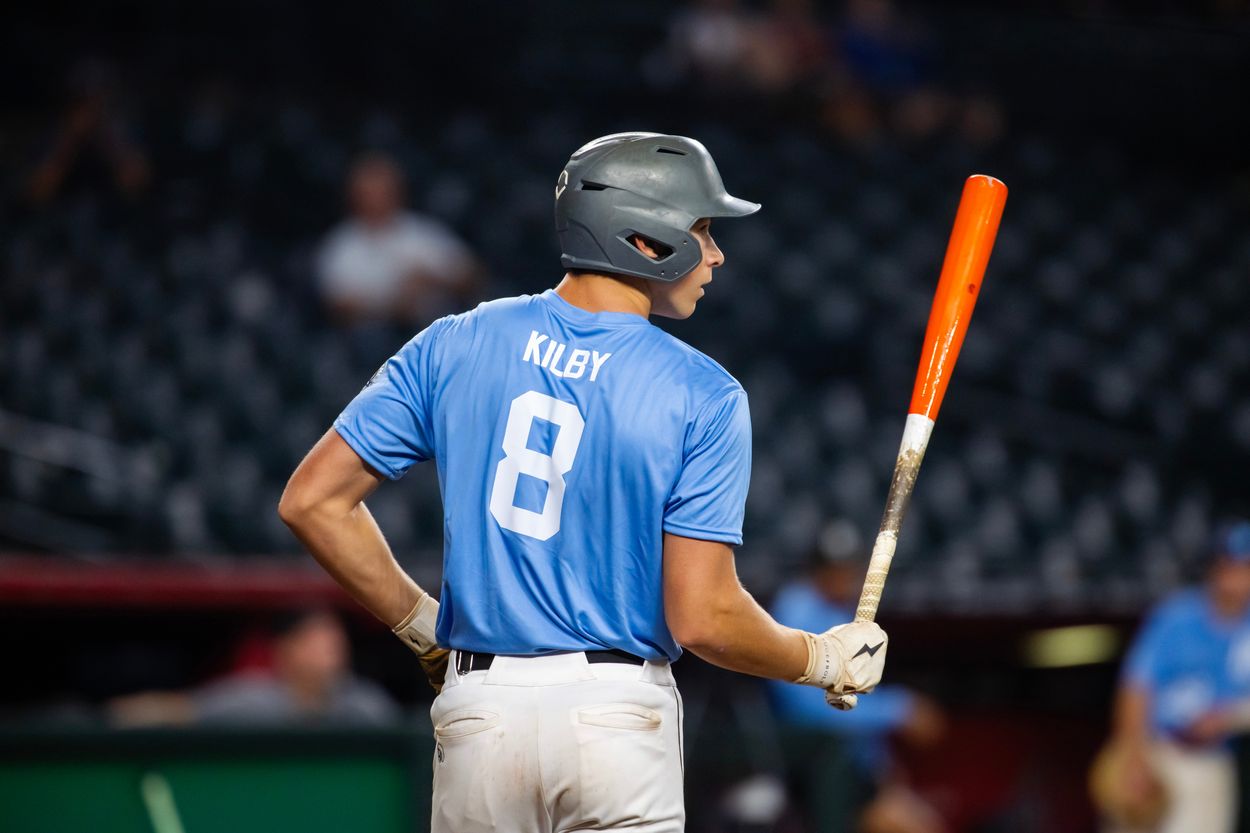
During the 2024 MLB Draft, the Yankees opened by selecting seven-consecutive pitchers, headlined by first-round pick Ben Hess out of Alabama.
This year, the Yankees had a more balanced mix of hitters and pitchers, and we’re overviewing all 19 of the Yankees’ draft picks from the 2025 class.
From Dax Kilby (no. 39 overall) to Bryce Martin-Grudzielanek (no. 614 overall), here’s a quick report from each of their new prospects.
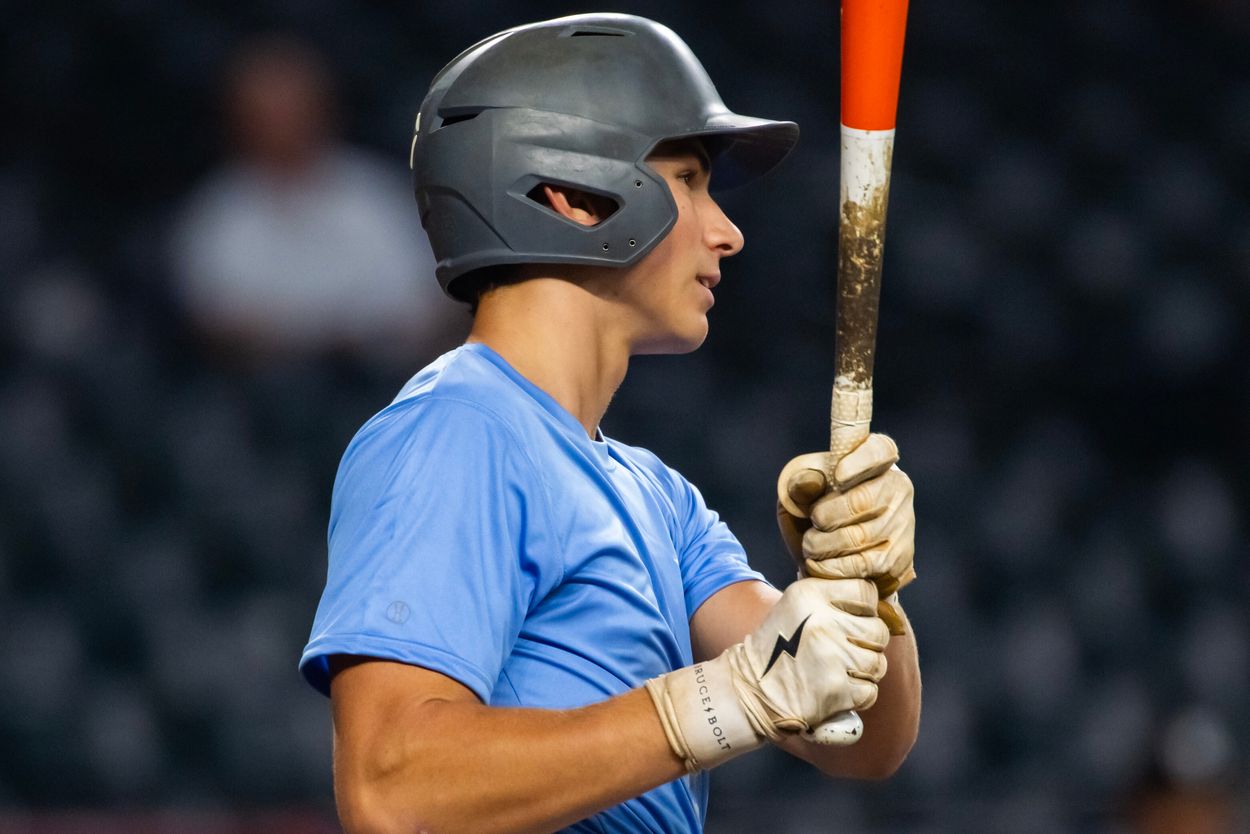
First Round (no. 39): SS Dax Kilby (B/T: L/R)
Drafted out of Newman High School, the Yankees’ new infield prospect brings a dynamic hit tool to the table, making tons of contact in-zone.
Kilby has been lauded for his swing decisions and plate discipline, and the Yankees could help him tap more into that pull-side power as he continues to grow into his 6’2 frame.
Dax Kilby is a strong athlete who moves well, and while there is skepticism on whether he’ll stick at shortstop or not, the mobility should allow him to find a defensive home somewhere and perform well.
The Yankees have a top 10 prospect in their organization in the prep high school bat, and the upside/uncertainty that comes with trying to project an 18-year-old brings some excitement about how he could develop.
Third Round (no. 103): SS Kaeden Kent
A college bat who became beloved at Texas A&M, Kaeden Kent has a very well-rounded skillset offensively, generating a good amount of pull-side power from the left-handed side.
He struck out in under 14% of his plate appearances and had more walks than strikeouts in his final season at College Station.
The son of long-time infielder Jeff Kent, Kaeden is also an infielder and has tons of versatility, as he played at all four infield positions throughout his college career.
He’s also played the outfield, and the Yankees could utilize those skills to have a super utilityman.
Fourth Round (no. 134): LHP Pico Kohn
A tall bulky left-hander, Pico Kohn has a fastball sitting around 92 MPH with good ride and tail, but his weird release point makes this pitch fascinating.
Kohn has a crossbody action which creates a very wide release point, causing his fastball to have a high swing-and-miss rate in the zone.
His big looping curveball and tight gyro slider are enticing pitches, and I believe the Yankees could help him develop a strong changeup.
This is my favorite pick of the draft, Kohn has room to add more velocity which would make his already dynamic fastball even better, and the Yankees tend to do very well with helping pitchers add velocity.
It’s also not lost on me that Kohn, who struck out almost 33% of batters faced, did so throwing his fastball over 60% of the time, if he can consistently use his secondary pitches we could be looking at a mid-rotation starter.
Fifth Round (no. 164): SS Core Jackson
Born in Canada, Core Jackson was brilliant for Utah in the Big 12 as he crushed 12 home runs in 48 games, swiped 20 bases, and posted a 1.086 OPS.
He has a simple and compact swing from the left-handed side with good speed, and there’s a chance he ends up sticking at shortstop which should help his overall projection.
Jackson is an aggressive swinger and is a SLG% machine because of it, attacking pitches in-zone and hoping to make an impact with a hit versus waiting for the count to play out.
The plate discipline will need work, and you wonder how he’ll perform against better competition at the professional level, but the pull-side power should play well at Yankee Stadium.
Sixth Round (no. 194): RHP Rory Fox
A full-time starting pitcher for the very first time last season, Rory Fox pitched to a 3.58 ERA and struck out 64 of the 280 batters he faced (23%).
While he’s touched 96 MPH before, he sits more in the lower 90s, sporting a slider, changeup, and curveball to pair with that fastball.
Fox has a very classic mix for a starting pitcher, with four pitches that have very distinct movement profiles, and the upside is that the Yankees can take a repertoire full of middling pitches and make one or two of them above-average.
A starter who has one or two above-average pitches and two other pitches that are around average should be effective at the Major League level, and the Yankees have done well in this range of picks.
Chase Hampton (6th Rd), Cam Schlittler (7th Rd), Richard Fitts (6th Rd), Will Warren (8th Rd), Griffin Herring (6th Rd) are all recent examples from the last four draft classes who have been selected around this range by the Yankees.
READ MORE: Yankees’ elite defensive catcher just became trade bait
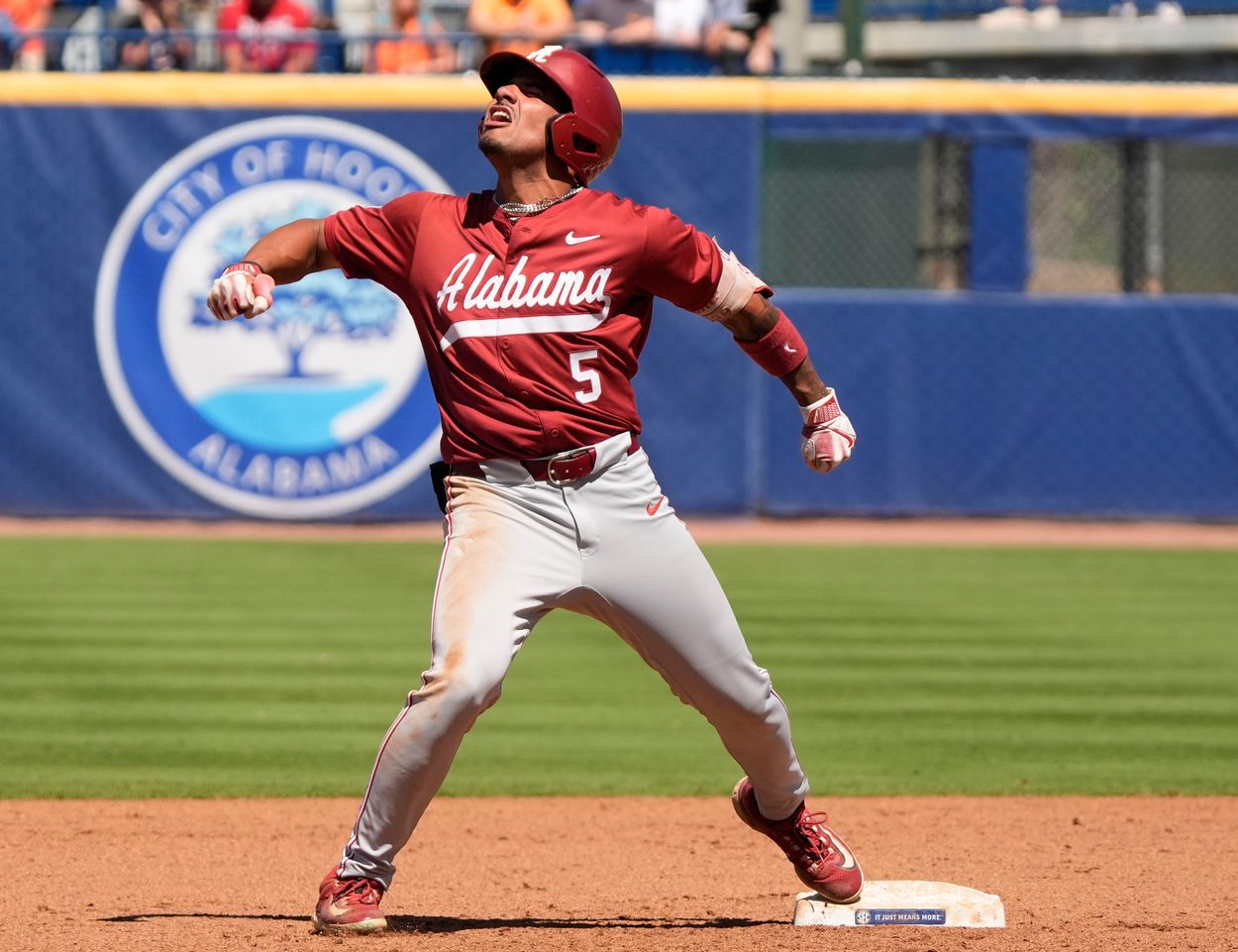
Seventh Round (no. 224): OF Richie Bonomolo Jr.
A New York native who went to high school in the Bronx, Richie Bonomolo Jr. is a right-handed hitting outfielder with plenty of speed who performed well in his lone season at Alabama.
Bonomolo performed brilliantly at Wabash Valley Community College before transferring over to Alabama, and he posted a .943 OPS with 16 steals, 17 doubles, and eight home runs in 59 games.
He made a good amount of contact with a lot of walks, and one of the traits that stand out to me is the defense, which could allow him to stick in centerfield as a big-leaguer.
There’s a solid amount of power in this profile, and the Yankees have selected one of the better athletes in this draft class in the middle rounds, a healthy add when trying to chase upside this deep in the draft.
Eighth Round (no. 254): RHP Mac Heuer
Mac Heuer had a 6.28 ERA and walked 23 of the 243 batters he faced as a starter for Texas Tech last season, struggling to land strikes throughout his pro career.
The Yankees are targeting upside here; Heuer is a beefy 6’5 hurler whose fastball can touch 98 with elite spin and movement.
He projects as a reliever due to the lack of strong secondaries or command, but as I highlighted earlier, the Yankees have done well in drafting strong prospects in the mid rounds of the draft.
Heuer might benefit from Major League conditioning, the resources poured into player health at the college level are strong, but they cannot rival what the Yankees provide.
There’s a lot to dream on here, but there’s also a lot that Mac Heuer will need to improve to realize his potential.
Ninth Round (no. 284): RHP Blake Gillespie
Blake Gillespie has a nasty slider with good shape and brilliant command, the pitch that headlines a repertoire which performed brilliantly in his senior season.
He struck out 34% of batters faced with a 4.9% walk rate at UNC Charlotte, but the competition he faced wasn’t great and his fastball velocity lags behind a bit.
Gillespie struggled at Georgia, transferring out and putting himself on the map with utter domination, but his finesse profile is one that teams can overlook in the draft process as upside is the biggest variable in draftability.
If the Yankees can help him improve from his 92-93 MPH fastball velocity and if the secondaries outside of the slider develop, we could be looking at a pretty impressive hurler.
With advanced strike-throwing abilities, Gillespie has the upside to become a serviceable backend starter in the big leagues.
Tenth Round (no. 314) 2B Connor McGinnis
After transferring from JUCO ball, Connor McGinnis crushed in his lone season at Houston, hitting 14 doubles in a 1.060 OPS with four home runs.
The appeal here is that he makes a good amount of contact and his compact swing could allow him to immediately perform at the lower levels of the Minor Leagues.
A massive discrepancy in doubles and home runs would lead me to believe there is more to unlock in terms of getting the ball out of the yard, especially for someone hoping to one day reach Yankee Stadium.
McGinnis will be 23 years old this winter, so he’ll hope that his age advantage can lead to some swift promotions from Single-A and High-A.
Eleventh Round (no. 344 overall): RHP Ben Grable
Both a starter and reliever for Indiana last year, Ben Grable posted a 4.31 ERA and struck out 65batters in 56.1 innings pitched.
He hit 101 MPH in 2023 and has a tall frame with very long arms, but after losing his 2024 season due to injury, he has been closer to the low/mid 90s.
Grable possesses a tight gyro slider and a strong splitter, both of which are pitches that could induce tons of whiffs at the next level.
At 23 years old, Grable is a bit older than the average draftee, but if the Yankees identify traits they like to develop more velocity, he could be dynamic.
It’s a huge gamble to take on someone who has an injury history and isn’t young relative to college pitchers, but you always pay attention to any pitchers the organization picks up.
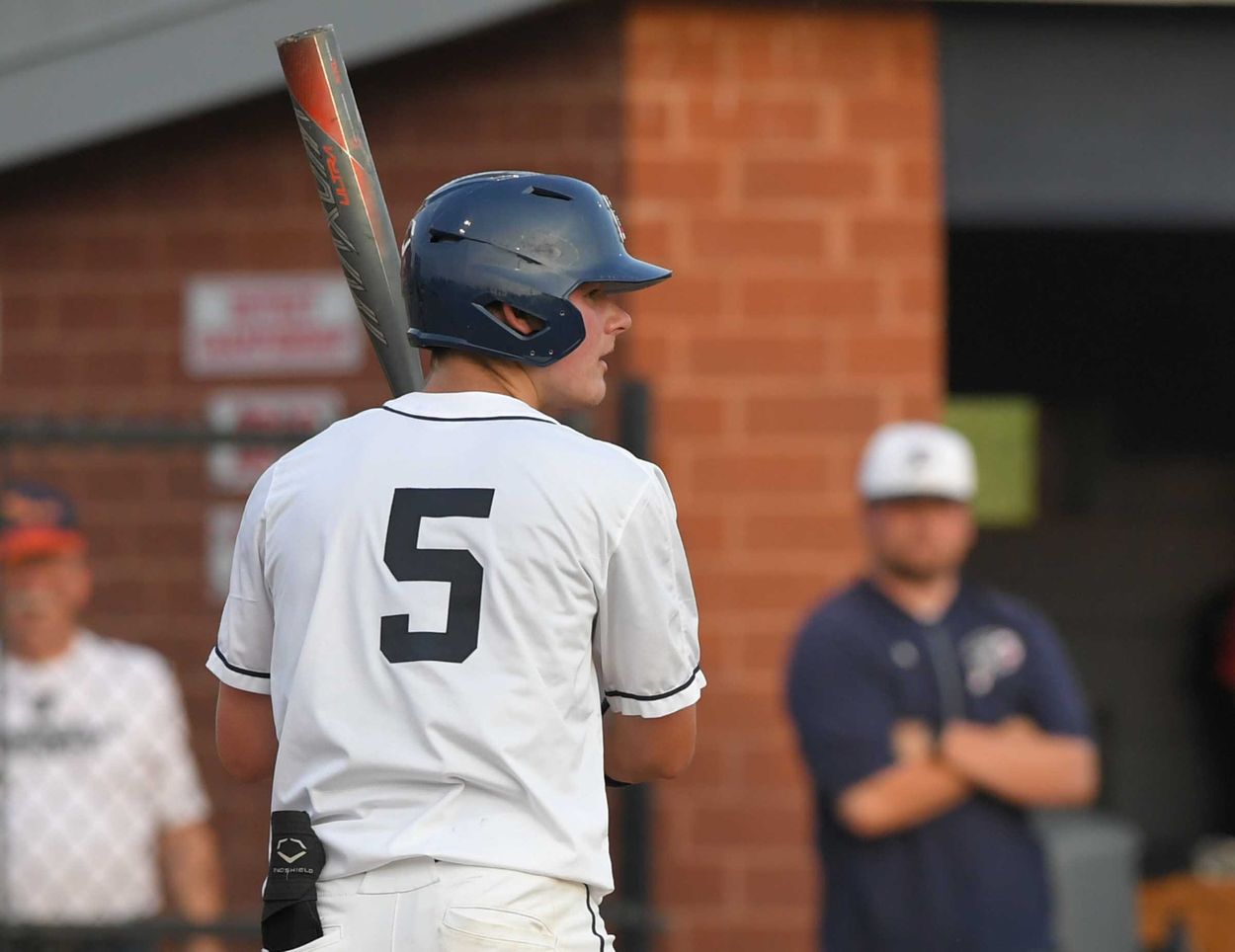
Twelfth Round (no. 374): OF Camden Troyer
The left-handed hitting outfielder out of Delaware was brilliant for Liberty last season, hitting 10 home runs in 56 games with a .930 OPS.
He worked 30 walks to just 21 strikeouts, and while the competition faced isn’t elite compared to some of the players who go earlier in the draft, Troyer’s well-rounded offensive approach is appealing.
There’s some power from the left-handed side, decent athletic abilities, good contact rates, and strong plate discipline that could result in a solid pro hitter.
As a corner outfielder, he won’t get much work in centerfield and therefore that knocks his overall projection, but if the bat plays that won’t matter too much.
Thirteenth Round (no. 404): OF Kyle West
Kyle West demolished the Big 12, posting one of the 10 best OPS marks in the league (1.088) while hitting 11 home runs and 15 doubles in 59 games.
He walked more than he struck out, seeing a massive decrease in strikeout rate from the year prior, but there are some real defensive concerns.
West is primarily a first baseman and corner outfielder, so if he is stuck at either position, it’ll be hard to project an above-average regular without having a strong big-league bat.
A tall strong left-handed slugger, Kyle West is a hitter who has generated some impressive exit velocities and could provide enough power to be a big-leaguer.
Fourteenth Round (no. 434): RHP Brennan Stuprich
A strong performer at Southeastern Louisiana, Brennan Stuprich struck out 109 batters in 90 innings pitched with just 38 walks and a 2.90 ERA.
Hailing from the same college that Will Warren came from, Stuprich is an overperformer who is just 5’10 and yet found tons of success at the Division 1 level.
A big issue with his profile stemmed from the lack of whiffs, but he went from an ugly 6.2% K-BB% in 2024 to a 20.3% in 2025, and if this surge in whiffs is a continued upward trend, the Yankees could have a fun project here.
Stuprich is the kind of pitcher who had to outwork those around him to even get drafted, so with big-league resources, that chip on his shoulder could propel him to an unlikely big-league debut.
Fiftheenth Round (no. 464): RHP Jack Cebert
A starter at South Florida who converted to a reliever role with Texas Tech, Jack Cebert posted a 3.60 ERA with 54 strikeouts in 60 innings.
Cebert has a fastball to go with a big curveball and a sharp slider, and while relievers tend to have very low ceilings, the Yankees could use a bit more success with finding relievers from within.
The multi-inning versatility and starter background could make Jack Cebert an interesting bullpen weapon who could make an impact at the MLB level.
Sixteenth Round (no. 494): SS Jackson Lovich
A 6’4 shortstop, Jackson Lovich crushed it in his senior season, slashing .357/.430/.622 with a 1.052 OPS and 12 home runs in 51 games.
With 52 strikeouts in 216 games, the bat-to-ball skills will need a lot of work to translate at the professional level, but the frame and power are enticing.
Lovich profiles to be a corner infielder, most likely at third base, and his swing from the right-handed side is full of pop that can hopefully be materialized into a strong pro bat.
READ MORE: Star infielder eyes possible Yankees deadline trade: ‘I would do my best’
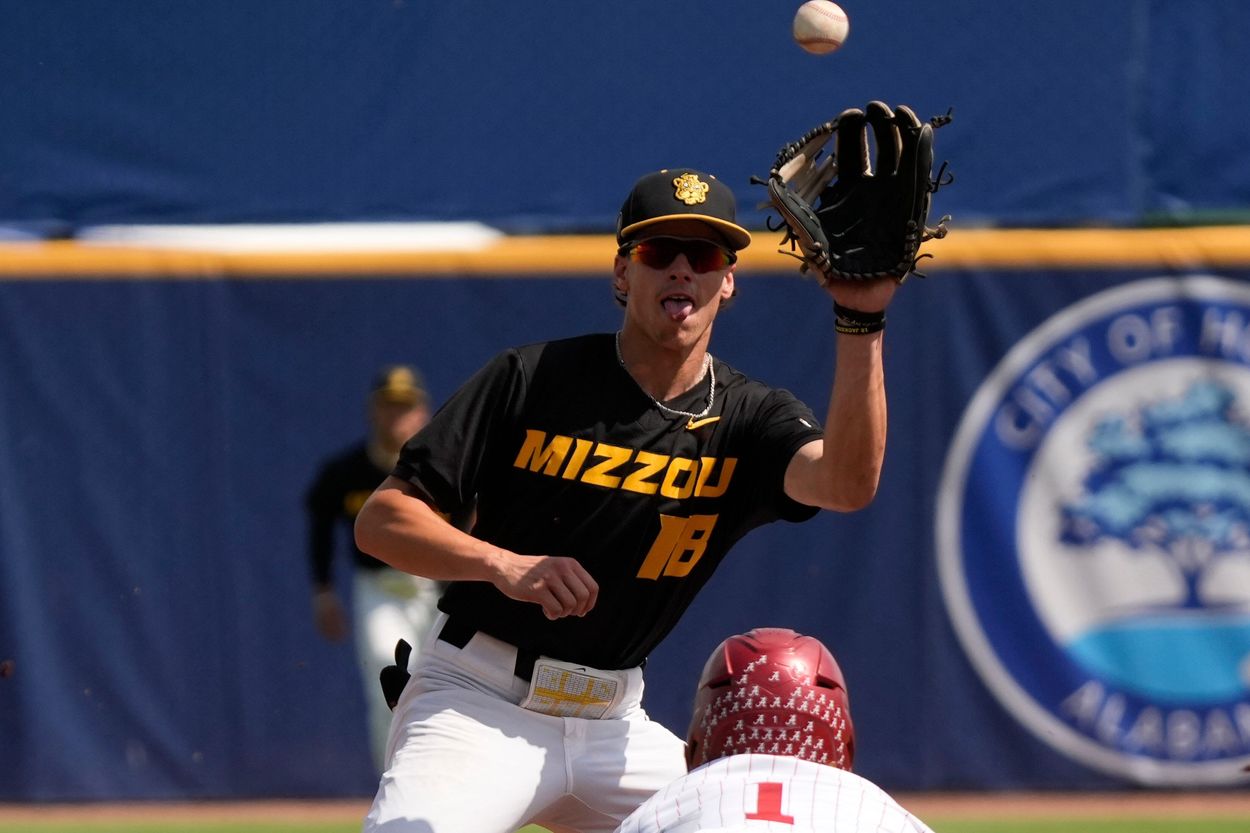
Seventeenth Round (no. 524): RHP Ryan Osinski
A reliever who hit 99.5 MPH, Ryan Osinski struggled at Virginia with a 5.57 ERA and 14 walks in 21 innings pitched in the ACC.
Osinksi has a power fastball and will need to overhaul a lot to stick at the pro level, the command is unreliable and the secondaries aren’t refined enough.
The Yankees are good with pitchers and Osinksi brings the raw velocity that a lot of pitchers in the organization do not have.
Eighteenth Round (no. 554): LHP Justin West
Justin West posted a 5.59 ERA with Louisville this year, but his 52 strikeouts in 37 innings pitched are enticing and there’s some upside to chase here.
West has a tall frame with some solid secondaries, and if his low-90s fastball can see a bit of an uptick, we could be looking at a solid reliever.
Command issues (11.8% BB%) have plagued West at times, but this late into the draft, landing someone with that swing-and-miss potential is solid.
Nineteenth Round (no. 584): RHP Hayden Morris
A tall right-handed pitcher who is listed at 6’8, he has a strong fastball and slider, sporting good velocity and movement with upside.
In 86.1 innings pitched at Blinn College, he struck out 106 batters with 48 walks, and if the Yankees can help him remain a starter, the upside’s very enticing here.
His command needs work and he might need to become a reliever in order to have consistent pro success, but I like the raw stuff and there’s a lot of upside relative to the round selected.
Twnetieth Round (no. 614): Bryce Martin-Grudzielanek
A shortstop from USC who was also selected in the 20th Round of the 2024 MLB Draft (that time by the Blue Jays), he posted a modest .797 OPS.
There are some very real contact concerns, but with eight home runs in 60 games, Bryce Martin-Grudzielanek set a new career-high in home runs.
The final pick of the Yankees’ 2025 MLB Draft class, Martin Grudzielanek will likely report to Single-A with a chance to move up to High-A quickly due to having a lot of collegiate experience.
!function(){var g=window;g.googletag=g.googletag||{},g.googletag.cmd=g.googletag.cmd||[],g.googletag.cmd.push(function(){g.googletag.pubads().setTargeting(“has-featured-video”,”true”)})}();